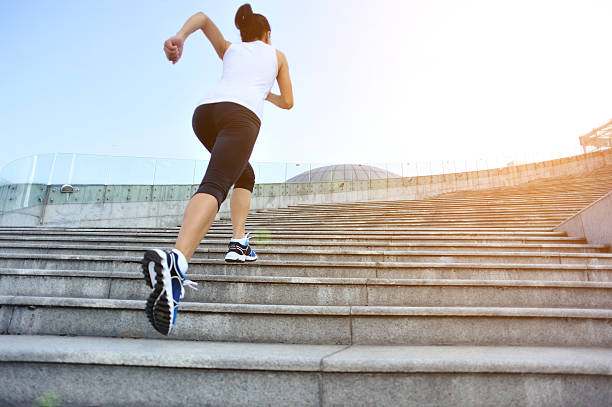Looking for a workout routine that doesn’t require equipment or a gym membership? Consider stair climbing, which is a good way to improve cardiorespiratory fitness, strength, and agility as well as burn calories (5 to 10 calories per minute).
You can start with 25 steps or so and gradually increase the number you climb. Your goal can be a certain number of steps or flights of stairs or a set amount of time going up and down. To make it more interesting and boost fitness even more, you can do interval training on the stairs—alternate stepping at a slow to moderate pace with brief intervals at a fast pace. If you go to a gym, you can use a stair-climbing machine. And since even short bouts of exercise accumulated during the day can have health benefits, if you live or work on a higher floor, consider taking the stairs instead of the elevator.
However you do it, watch your posture: Keep your back erect or bend slightly forward from your hips. Pumping your arms and making an effort to push off the ball of your foot with each stride will increase the workout.
Note: Stair-climbing workouts can be very strenuous, so start out slowly and gradually increase the time and intensity. As with any strenuous exercise, if you are sedentary and have a chronic medical condition, arthritis of the knee, or biomechanical problems, it’s prudent to consult a health care provider or physical therapist about the advisability of stair exercise.
Table of Contents
Should you avoid holding on to the railing?

You may want to keep a light hand on the railing, especially if your sense of balance isn’t good or if you’re trying to increase your speed. If you use the railing to pull yourself up the stairs, you get an upper-body workout. Some people who do challenging stair-climbing workouts pull themselves up by the railing in order to go faster and take some strain off their legs. Some use a single hand on the railing, while other climbers use both hands in a more difficult but propulsive hand-over-hand technique.
Should you swing your arms?
Only if your sense of balance is good enough. Swinging your arms not only helps propel you up the stairs, but also gives your shoulders, chest, back, and arms a workout.
Is climbing two steps at a time more beneficial?
It will give muscles in your legs (notably the quadriceps) and buttocks a more strenuous workout and will burn more calories per minute. But the longer stride can be risky if you have knee problems, poor balance, or short legs (which can lead to a groin injury). You can vary your workout by switching from single-step to double-step climbing.
Is walking down stairs also beneficial?
Yes. Going up stairs is more strenuous, but going down has its own benefits and is a good form of “eccentric exercise,” in which muscles are lengthened by the load they are contracting against. When going down stairs, the front thigh muscles (quadriceps) perform eccentric contractions to support the body on each stair. But going down can be hard on your knees, so don’t overextend or lock them. If you go down stairs (or downhill) a lot, you can put excessive strain on the knees or develop sore quadriceps, though the soreness will decrease with practice.
Interestingly, a study from Taiwan in Medicine & Science in Sports & Exercise in 2017 found that walking down stairs can be even more beneficial than going up in some ways. It had 30 healthy but sedentary obese women (ages 60 to 82) engage in progressive aerobic training on five flights of stairs (110 steps), either by going only up or only down (they took an elevator to go the other direction), twice a week for 12 weeks, gradually increasing the number of flights per week. Both groups benefited, but while women going up stairs got more of an aerobic workout, those going down stairs had greater improvements in blood pressure, blood cholesterol, blood sugar, bone density, and functional fitness.
Of course, in the real world, people generally go up and down stairs, which gives leg muscles a more balanced workout. Many stair-climbing machines (and elliptical trainers) allow you to reverse your motion, but that doesn’t replicate walking down stairs.
Are you better off repeatedly going up and down, say, 2, 5, or 10 flights (assuming you’re in a building that tall)?
We could find no studies comparing the benefits of such stair-climbing patterns. You can experiment with different numbers of flights up and down to see what suits you. Going up 10 flights can tire your legs more than shorter ascents, though this will depend on whether you’re used to it or not, how many times you go up and down, how quickly, and how long you rest in between.
Many studies have shown that climbing stairs quickly, rather than going slowly for a longer time, can provide added cardiovascular benefits. For instance, a small study in the British Journal of Sports Medicine in 2005 found that briskly climbing eight flights five days a week for eight weeks (starting with one ascent a day and working up to five) resulted in a significant improvement in aerobic capacity as well as an 8 percent reduction in LDL (“bad”) cholesterol.
While some studies have involved doing dozens of flights a day, others have found that fewer flights provide benefits as well. A study dating back to 1999 found that stair climbing (10 flights a day, on average) was associated with increased bone density in postmenopausal women.
How does climbing stairs differ from using a stair-climbing machine?
There are many differences, but it would depend, in part, on the design of the machine and how closely it mimics real stair climbing. Using a stair-climbing machine (such as the Stairmaster) generally puts less stress on hips, ankles, and knees than real stair climbing, which could be an advantage if you have arthritis or biomechanical problems. On the other hand, real stair climbing tends to allow these joints to move through a fuller range of motion than using stair machines, which is a plus. Also, because it involves greater impact, real stair climbing would have greater bone benefits. In addition, with machines, you mimic only climbing up and not going down, so you don’t get to work your quads eccentrically. Holding on to the handrails will reduce the intensity of the workout.




